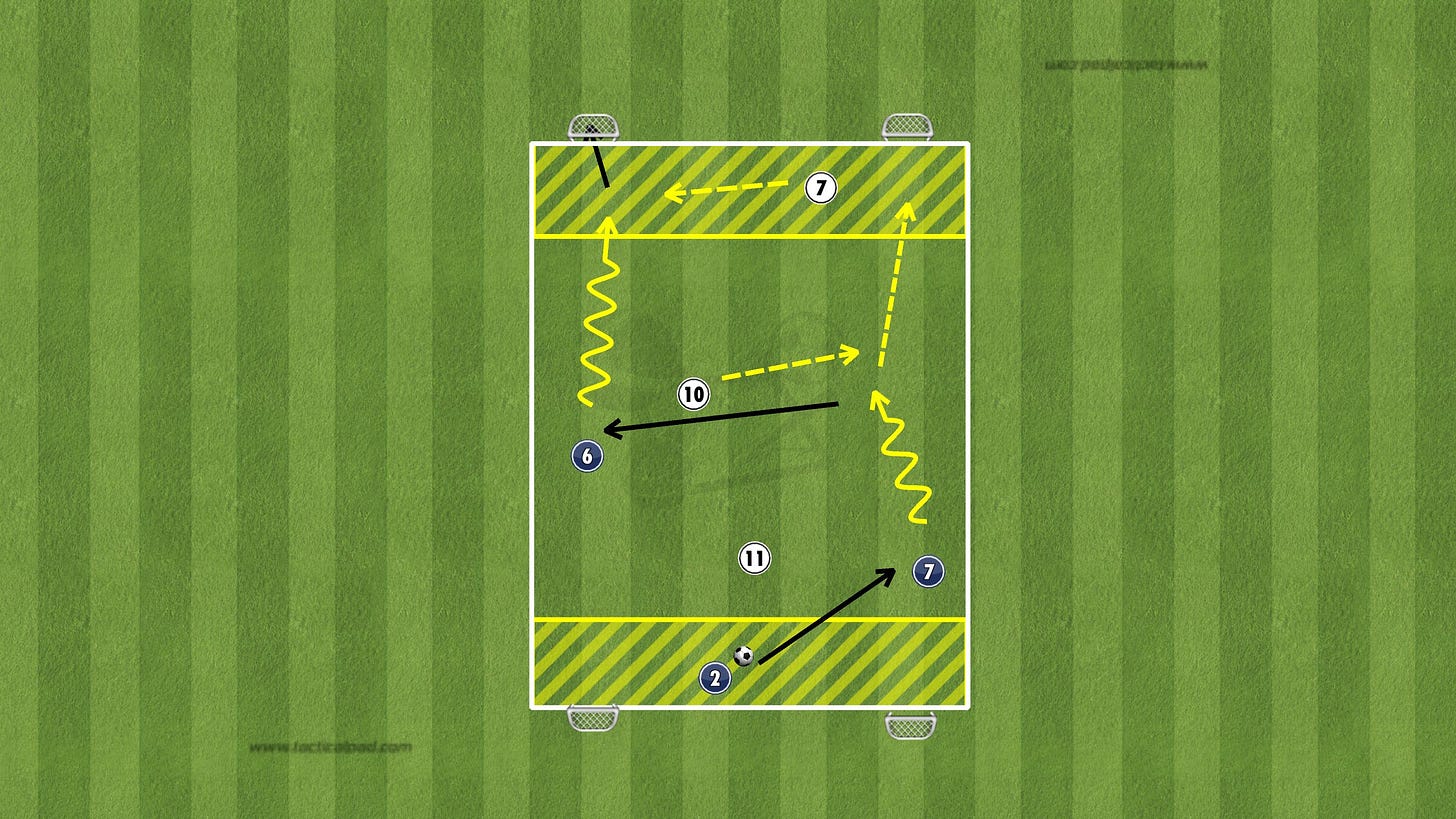Last week I touched on the issue of teaching concepts versus teaching patterns via team structure. As promised, here are some activities I use to train game situations in a general sense instead of via their positions. I want to create players with robust game intelligence that isn’t limited by having memorized the situations they commonly see in their main playing position.
TAKEAWAYS
After reading today’s article you will:
understand why teaching general game situations is critical
have several activities that can be used to train small game situations
BACKGROUND
While teaching team structure can help a team compete against less organized teams, it also masks the individual’s deficiency in interpreting and resolving common game situations. An additional risk is that errors tend to be viewed through the team structure lens, leading to training sessions that continue to refine the specific application of these smaller situations.
In other words, instead of teaching players to solve a 2v1, they are put in a specific situation with players in positions and are taught to resolve it how the coach wants. This isn’t terrible by any means, but the risk is that players essentially memorize how to play certain game situations based on their playing position, as opposed to learning the more general concepts at play. When this happens, players end up specializing in their positions almost inadvertently because they don’t understand the underlying principles at work.
Teaching in a way that yields a more robust understanding will undoubtedly take longer, but the players will be much more flexible. Capable of playing in different positions and solving a greater variety of situations with ease.
With that being said, here are some activities I use to train game situations in a general way. I recommend taking the breakdowns from the game and taking the specificity out of it. Reduce those breakdowns to simple numbers and then give the players a lot of practice on how to solve them.
1v1+1
RULES: The rules are simple. A 10x10 square and 5 consecutive passes = 1 point. Play for 5 minute rounds. Whoever has the ball plays with the neutral.
RATIONALE: I use this activity to get a high volume of reps of being in the first and second attacker roles. If Barcelona’s number one activity is the rondo, this game is mine. Players will revert to their most ingrained habits under pressure and I want mine to feel confident escaping pressure when all else fails. This activity also gives the 2nd attacker a ton of reps improving their anticipation of where to move and offering support at good angles/distances.
*Xavi famously stated in an interview several years ago that at Barcelona they played a rondo every single day and that it was the training activity most essential to their style of play.
**There is a clear line between teaching kids to dribble as the solution to every game situation and developing their capability to manage the ball under intense pressure from an opponent.
2v1 with wide goals
RULES: 15x10 area. Defender passes to the attackers who try to dribble the ball across the line. If defender steals it, they dribble across the attacker’s starting line.
RATIONALE: Still a 2v1 situation, but now with direction added. Many situations in the game can be broken down into basic 2v1s. This basic format is also quite easy to tweak by changing the starting position of players, the way the ball is played into the activity, etc. It’s very adaptable.
2v2 with support player in defensive zone
RULES: A 20x20 central area with two 10x20 end zones. In the corners of each end zone is a mini goal (4 total). Each team has two players in the middle (2v2) and one player waiting in the team’s own end zone. To score, the attacking team must bring the ball into the opponent’s end zone and then resolve the 2v1 to score in either mini goal.
RATIONALE: The presence of the deep player behind the ball means that the attackers can always recycle the attack when the ball carrier is stopped and doesn’t have a good opportunity to go forward. This is a great activity for reading when to go forward versus when to move the ball and try to find a bigger advantage elsewhere.
Many youth teams struggle with understanding the appropriate time to go forward which leads to attacks dying from poor decision making. I believe that coaches often think about their midfield players struggling with this decision making but the reality is that all players have to learn when to dribble, when to pass, when to go forward, when to circulate the ball.
CONCLUSION
These are three activities that I would use to train my players instead of putting them into their positions and teaching them to memorize situations they encounter in the game. This helps create better players because they can more flexibly apply the basic concepts even to situations that may otherwise seem completely new, such as when playing an unfamiliar position.
At the end of the day, my belief is that the best players have a rich understanding of the game and can make plays from a variety of different positions or roles. While the early 2000s may have seen the game evolve into very specialist positions, I think we are seeing the next evolution moving toward more generalists again. By developing players with a very good fundamental understanding of simple game situations, we can give them the chance to reach high levels even as the game’s demands continue to evolve.






